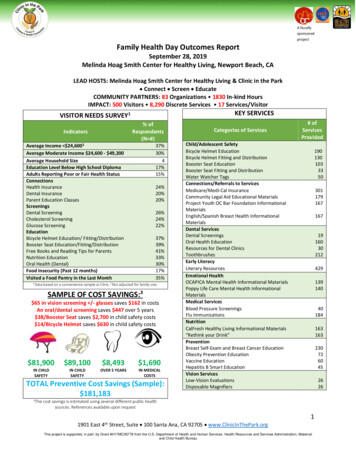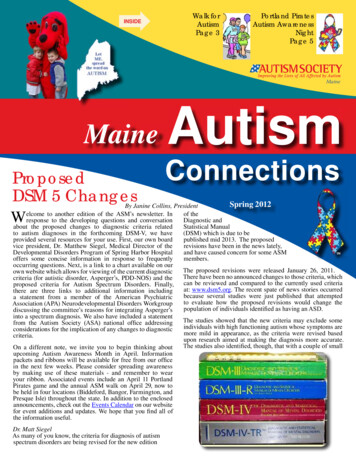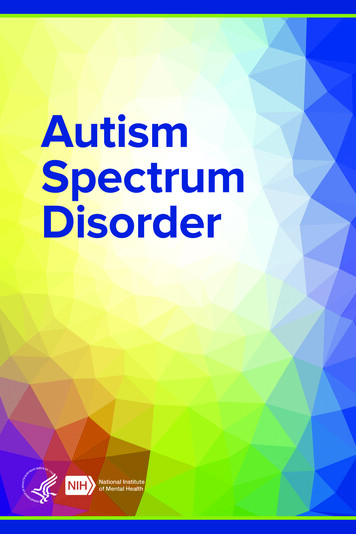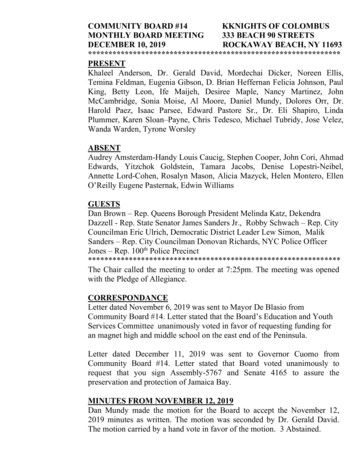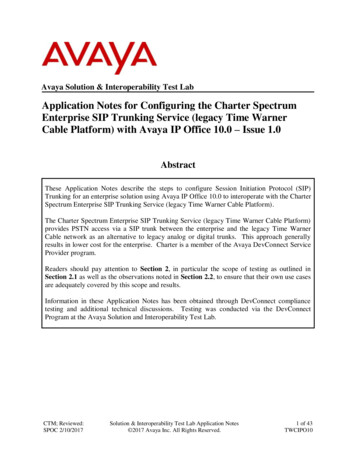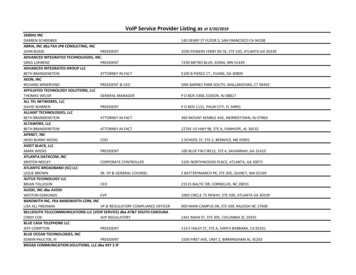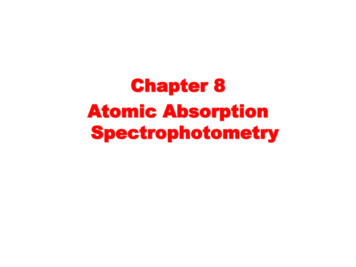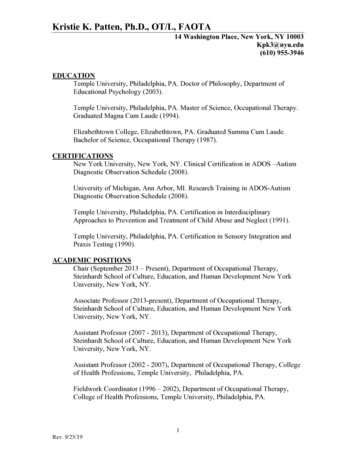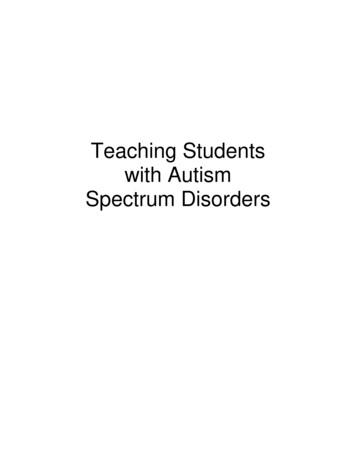
Transcription
Teaching Studentswith AutismSpectrum Disorders
ALBERTA LEARNING CATALOGUING IN PUBLICATIONAlberta. Alberta Learning. Special Programs Branch.Teaching students with autism spectrum disorders.(Programming for students with special needs)ISBN 0–7785–2547–31. Autistic children – Education – Alberta. 2. Special education – Alberta.3. Exceptional children – Alberta. 4. I. Title. Series: Programming forstudents with special needs. II. Alberta. Alberta Learning. Learning andTeaching Resources Branch.LC3984.2.A3.A333 bk.9 2003371.9For further information, contact:Alberta LearningSpecial Programs Branch8th Floor, 44 Capital Boulevard10044 – 108 StreetEdmonton, AB T5J 5E6Alberta LearningLearning and Teaching Resources Branch8th Floor, 44 Capital Boulevard10044 – 108 StreetEdmonton, AB T5J 5E6Telephone: (780) 422–6326 in Edmonton ortoll-free in Alberta by dialing 310–0000Fax: (780) 422–2039Telephone: (780) 427–2984 in Edmonton ortoll-free in Alberta by dialing 310–0000Fax: (780) 422–0576This resource is intended s99This resource can be downloaded free-of-chargeat www.learning.gov.ab.ca/k 12/specialneeds.Print copies of this resource can be purchased from theLearning Resources Centre. Order online atwww.lrc.learning.gov.ab.ca/ or telephone 780–427–5775.Copyright 2003, the Crown in Right of Alberta, as represented by the Minister of Learning.Alberta Learning, Suite 800, 44 Capital Boulevard, 10044 – 108 Street N.W., Edmonton, Alberta,Canada, T5J 5E6.Every effort has been made to provide proper acknowledgement of original sources. If cases areidentified where this has not been done, please notify Alberta Learning so appropriate correctiveaction can be taken.Permission is given by the copyright owner for any person to reproduce this document, or any partthereof, for educational purposes and on a nonprofit basis, except for those parts for which AlbertaLearning does not hold copyright.
AcknowledgementsAlberta Learning gratefully acknowledges the many teachers, otherindividuals and groups who have provided advice and feedbackover the course of the development of this resource, including thefollowing: Alberta Learning, Alberta, Canada Dr. Kim Ward, Society for Treatment of Autism, principalwriter Sandra Mann, Psychologist, Calgary Board of Education All the individuals and groups who reviewed the field-test draftand provided thoughtful suggestions and comments Members of the Special Education Advisory Committeerepresenting:Alberta Association for Community LivingAlberta Associations for Bright ChildrenAlberta Home and School Councils’ AssociationAlberta Learning, Adult Learning DivisionAlberta School Boards AssociationAlberta Society for the Visually ImpairedAlberta Teachers’ AssociationAutism Society of AlbertaCollege of Alberta School SuperintendentsCouncil for Exceptional Children (CEC), AlbertaFederationLearning Disabilities Association of AlbertaPremier’s Council on the Status of Persons with DisabilitiesSigning Exact EnglishSociety for the Educational Advancement of the HearingImpairedUniversity of Alberta, Department of EducationalPsychology Alberta Learning staff:Rick Hayes, Director, Special Programs BranchGina Vivone-Vernon, Director, Learning and TeachingResources BranchGreg Bishop, Team LeaderTony McClellan, Education ManagerMarilyn Tungland, EditorLin Hallett, Desktop PublisherDianne Moyer, Desktop PublisherSandra Mukai, Copyright OfficerAcknowledgements /i2003
Alberta Learning gratefully acknowledges the British ColumbiaMinistry of Education and Saskatchewan Education for providingthe text of the document, Teaching Students with Autism: A Guidefor Educators as a starting point for this resource.ii/ Teaching Students with Autism Spectrum Disorders2003 Alberta Learning, Alberta, Canada
Introduction to the SeriesThe following books are included in the Programming forStudents with Special Needs series. The information in eachbook is interrelated and can be used to provide instruction to allstudents.Book 1: Teaching for Student Differences(1995)Book 1 highlights strategies for differentiating instruction withinthe regular classroom for students who may be experiencinglearning or behavioural difficulties, or who may be gifted andtalented. It includes ideas for varying instructional time, thelearning environment, resources, materials, presentation,assignments and assessments to accommodate students withdiverse needs. This book contains instructional strategiesarranged by core subjects as well as by categories of differences,e.g., learning disabilities, behaviour disorders, and gifted andtalented. The appendices contain a variety of useful forms forteacher planning.Book 2: Essential and Supportive Skills forStudents with Developmental Disabilities(1995)Book 2 includes: developmental checklists for communication skills, e.g.,receptive, expressive, social, articulation and vocabulary checklists for gross and fine motor development, includingcolouring, graphics, manuscript printing and cutting charts and checklists which provide a continuum of life skillsby domain checklists for mathematics, reading and writing to Grade 6 an annotated list of teaching resources.Book 3: Individualized Program Plans(1995)Book 3 contains a process for IPP development and strategiesfor involving parents. This book provides information onwriting long-term goals and short-term objectives along withcase studies and samples of completed IPPs. It addressestransition planning, and features forms and checklists to assist inplanning. Alberta Learning, Alberta, CanadaIntroduction to the Series /iii2003
Book 4: Teaching Students who are Deafor Hard of Hearing (1995)Book 4 includes information on the nature of hearing loss andvarious communication systems. The book contains informationon amplification, educational technologies, program planningand teaching strategies.Book 5: Teaching Students with VisualImpairments (1996)Book 5 offers basic information to help provide successfulschool experiences for students who are blind or visuallyimpaired. The information in this book addresses: the nature of visual impairment educational implications specific needs instructional strategies the importance of orientation and mobility instruction the use of technology.Book 6: Teaching Students with LearningDisabilities (1996)Book 6 provides practical strategies for regular classroom andspecial education teachers. Section I discusses the conceptualmodel and applications of the domain model. Section II includesidentification and program planning, addressing earlyidentification, assessment, learning styles and long-rangeplanning. Section III contains practical strategies within specificdomains, including metacognitive, information processing,communication, academic and social/adaptive. Section IVaddresses other learning difficulties including attentiondeficit/hyperactivity disorder and fetal alcoholsyndrome/possible prenatal alcohol-related effects. Theappendices contain lists of annotated resources, test inventories,support network contacts and blackline masters.Book 7: Teaching Students who are Giftedand Talented (2000)Book 7 provides practical strategies for regular classroom andspecial education teachers. Section I addresses administration ofprograms for the gifted and talented at both the district andschool levels. Section II discusses conceptions of giftedness,highlighting nine theoretical models. Section III discussesidentification of gifted and talented students, includinginformation on gathering and recording data using severaliv/ Teaching Students with Autism Spectrum Disorders2003 Alberta Learning, Alberta, Canada
information on gathering and recording data using severaldifferent measures, developing individualized program plans,communicating with and involving parents. Section IVdiscusses giftedness in the visual and performing arts. Section Vcontains strategies for designing and implementing programs,including curriculum modification. Section VI discusses postmodernism and gifted education. The appendices contain lists ofannotated resources, test inventories, support network contactsand blackline masters.Book 8: Teaching Students with EmotionalDisorders and/or Mental Illnesses (2000)Book 8 takes a comprehensive look at six emotional disorders ormental illnesses: eating disorders, anxiety disorders, depression,schizophrenia, oppositional defiant disorder and conductdisorder. It describes the characteristics, symptoms and riskfactors that may trigger the onset of the disorder or illness, andpresents strategies for teachers, parents and other caregivers touse to assist students.Note:Children and StudentsIn Alberta, the School Act draws a distinction between childrenand students. In general, the term “student” refers to anindividual who at September 1 in a year is 6 years of age orolder and younger than 19 years of age. A “child” refers to anindividual who is younger than 6 as of September 1 of the yearthe child enters an educational program. In Alberta, childrenwith severe disabilities may be eligible for special educationprogramming at 2 ½ years at September 1.The information, approaches and strategies included in thisresource have wide applicability and are generally appropriatefor both children and students. For the sake of readability, theterm “student” will be used throughout this resource to refer toboth children and students who are eligible for special educationprogramming. Alberta Learning, Alberta, CanadaIntroduction to the Series /v2003
vi/ Teaching Students with Autism Spectrum Disorders2003 Alberta Learning, Alberta, Canada
Table of ContentsPageChapter 1: What are Autism Spectrum Disorders? .Prevalence .Causes .Diagnoses .Other Pervasive Developmental Disorders .Autism Spectrum Disorders: Myths .122357Chapter 2: Characteristics Associated with Autism Spectrum Disorders .Communication .Social Interaction .Unusual/Challenging Behaviours .Learning .Unusual Patterns of Attention .Unusual Responses to Sensory Stimuli .Anxiety .Final Thoughts on Characteristics .9911131415161819Chapter 3: Collaborating with Parents . 21The Experiences of Families . 21Collaborating with Parents . 24Chapter 4: Planning Support for Students with Autism Spectrum Disorders .Developing Individualized Program Plans (IPPs) .Strategies to Facilitate Effective IPPs .Integrated Case Management .31313436Chapter 5: Classroom Instruction .General Instructional Approaches .Effective Teaching Practices .Strategies for Addressing Sensory Issues .Strategies to Facilitate Communication .Strategies for Teaching Social Skills .Teaching Functional Skills .39394854606978Chapter 6: Managing Challenging Behaviour . 83Positive Behavioural Supports . 83Chapter 7: Facilitating Inclusion . 111Teacher Preparation . 111Preparing Students with Autism Spectrum Disorders . 112Promoting Understanding . 113Adapting Instruction . 114One-to-One Instruction . 120Promoting Positive Peer Interactions . 121 Alberta Learning, Alberta, CanadaTable of Contents /vii2003
Chapter 8: Transition Planning . 125Transition into the School System . 125Transitions Between Activities and Settings . 126Transitions Between Grade Levels . 127Transitions Between Schools . 128Transition from High School to Adult Life . 130Chapter 9: Students with Asperger’s Syndrome . 133Learning and Behavioural Characteristics . 133Strategies . 135Chapter 10: Case Studies . 139Karen: A Kindergarten Student . 139Alan: A Grade 6 Student . 150Rajinder: A Grade 11 Student . 160Appendices . 171A: Home-School Communication Book . 172B: Integrating IPP Goals with Regular Class Activities . 173C: Modification Planning Form . 175D: Hierarchy of Prompts . 176E: Task Analysis: Removing Outer Clothing . 177Task Analysis: Using the Bathroom . 178Task Analysis: Participating in Morning Circle . 179Task Analysis: Single-digit Addition Using Manipulatives . 180Task Analysis: Asking a Peer to Play . 181Blank Task Analysis Data Sheet . 182F: Likes and Dislikes Chart: Student Preferences . 183G: Checklist of School Reinforcers . 184H: Communication Dictionary . 185I: Behaviour Observation and Data Collection Chart . 186J: Motivation Assessment Scale . 187K: Behaviour Support Plan . 189Resources . 193Regional Educational Consultation Services . 193Diagnostic Services . 194Internet Resources . 194Organizations . 195Video Resources . 196Recommended Print Resources . 197Endnotes . 203Bibliography . 207Feedback. 219viii/ Teaching Students with Autism Spectrum Disorders2003 Alberta Learning, Alberta, Canada
Chapter 1: What are AutismSpectrum Disorders?Autism spectrum disorders are lifelong developmental disabilitiesthat can impact how people understand what they see, hear andotherwise sense. This can result in difficulties with socialrelationships, communication and behaviour.The Diagnostic and Statistical Manual of Mental Disorders,DSM-IV (American Psychiatric Association, 1994) defines autismspectrum disorders as pervasive developmental disorderscharacterized by: qualitative impairment in social interaction qualitative impairment in communication restricted, repetitive and stereotypic patterns of behaviour,interests and activities.It is a complex neurological disorder that affects the functioning ofthe brain.Autism spectrum disorders symptoms can be present in a varietyof combinations and may accompany other disabilities.1 Somepeople with autism spectrum disorders have normal levels ofintelligence, while most have some level of intellectual disability,ranging from mild to severe. This range is often referred to ashigh-functioning autism spectrum disorders to low-functioningautism spectrum disorders.There is also a range of difficulties in expressive and receptivelanguage and communication. It is estimated that a highproportion of individuals with autism spectrum disorders, up to 50percent, do not develop functional speech. For those who do,speech may have unusual qualities and limited communicativefunctions.All people with autism spectrum disorders display difficulties withsocial interaction and behaviour, but the extent and type ofdifficulty varies. Some individuals may be withdrawn, while othersmay be overly active and approach people in socially-awkwardways. They may demonstrate selective attention, resistance tochange, limited interests or obsessive behaviours. They oftenrespond to sensory stimuli in an atypical manner and may exhibitunusual physical behaviours, such as hand flapping, spinning orrocking. They may also use objects in unconventional ways anddemonstrate an unusual attachment toward specific objects. Alberta Learning, Alberta, CanadaWhat are Autism Spectrum Disorders? /12003
Although people with autism spectrum disorders may sharecommon features, no two individuals share an identical profile. Inaddition, the pattern and extent of difficulties may change asindividuals grow older. There are common characteristicsassociated with autism spectrum disorders but it is important tocombine this information with knowledge of the specific interests,abilities and personality of each individual.PrevalenceThe generally accepted prevalence rate for autism spectrumdisorders has been 4–5 in every 10 000 births. However, recentestimates suggest a rate of about 1 in 500 when a broader spectrumof disorders is included.2 There is a higher prevalence amongmales. The ratio varies depending on the definition, but studiesreveal a male-to-female ratio between 4:1 to 5:1.CausesThe cause or combination of causes of autism spectrum disordersis not fully known. There is growing evidence that autismspectrum disorders is a genetic condition and that there are likelyseveral different genes involved.3 The mode of genetictransmission appears complex, and scientists are focusing theirwork on discovering which genes may be involved and how thesegenes are affected. So far, it appears that for at least a significantsubgroup of people with autism spectrum disorders, there is agenetic susceptibility that differs across families (that is, differentgenes may be responsible in different families).4 Early life events,e.g., complications during the pregnancy, and environmentalfactors are believed to interact with genetic susceptibility.Autism spectrum disorders are associated with a number ofbiological causes, however none is unique to the syndrome. Forinstance, autism spectrum disorders has been associated withprenatal exposure to rubella, chromosomal abnormalities, such asFragile X, as well as brain abnormalities, such as hydrocephalus.Many consider autism spectrum disorders to be a “final commonpathway” as there are many different possible causes.Recently, various types of investigations, including imagingstudies, electro-encephalographic studies, tissue studies on autopsysamples and neuro-chemical studies, have provided furtherevidence of a biological basis for autism spectrum disorders. Thebrains of individuals with autism spectrum disorders appear tohave structural and functional differences from the brains of otherpeople. Anomalies in the brain stem and cranial nerves have been2/ Teaching Students with Autism Spectrum Disorders2003 Alberta Learning, Alberta, Canada
found. Ongoing research may one day pinpoint the exact genesand other conditions that combine to cause autism spectrumdisorders.5DiagnosesAt present, there is no definitive medical test to identifyindividuals with autism spectrum disorders. The diagnosis istypically made by a pediatrician, child psychiatrist or clinicalpsychologist with expertise in the area of autism spectrumdisorders. Ideally, assessment and diagnosis involve amultidisciplinary team that includes a pediatrician or psychiatrist, apsychologist and a speech-language pathologist. The psychologistoften administers assessments to gather information aboutdevelopment and behaviour, and the speech-language pathologistassesses speech, language and communicative behaviours. Amedical assessment is conducted to rule out other possible causesfor the symptoms, as many of the characteristics associated withautism spectrum disorders are also present in other disorders. Amedical and developmental history is taken through discussionwith parents. This information is combined with the otherassessments to provide an overall picture and rule out othercontributing factors.Professionals diagnose autism spectrum disorders through thepresence or absence of certain behaviours, characteristic symptomsand developmental delays. The criteria are outlined in the DSM-IVand the International Classification of Diseases (World HealthOrganization, 1993).Pervasive orderPervasiveDevelopmentalDisorder NotOtherwiseSpecified Alberta Learning, Alberta, CanadaThe DSM-IV classifies autism spectrum disorders as a disorderwithin a broader group of Pervasive Developmental Disorders(PDD). PDD is an umbrella term for disorders that involveimpairments in reciprocal social interaction skills andcommunication skills, and the presence of stereotypicalbehaviours, interests and activities. The conditions classified asPDD in the DSM-IV are: Autistic Disorder Asperger’s Disorder Rett’s Disorder Childhood Disintegrative Disorder (CDD) Pervasive Developmental Disorder Not Otherwise Specified(PDD-NOS).Some of these diagnostic terms appear to be used interchangeablywithin the literature and by practitioners. The term AutismSpectrum Disorders (ASD) is sometimes used to refer to autismWhat are Autism Spectrum Disorders? /32003
and other conditions included within the PDD classification. PDDis sometimes used to refer to all conditions within the category ofPDD, and at other times is used to refer to PDD-NOS. Whenpeople from different disciplines are working together to supportstudents it is important to clarify the use of terminology.The DSM-IV criteria for autism spectrum disorders are includedbelow.Criteria for autistic disorder in the DSM-IV (299.00)6A. A total of at least six items from (1), (2) and (3), with at leasttwo from (1), and one from (2) and (3):(1) Qualitative impairment in social interaction, as manifestedby at least two of the following:(a) Marked impairment in the use of multiple nonverbalbehaviours such as eye-to-eye gaze, facial expression,body postures and gestures to regulate socialinteraction(b) Failure to develop peer relationships appropriate todevelopmental level(c) Markedly impaired expression of pleasure in otherpeople’s happiness(d) Lack of social or emotional reciprocity.(2) Qualitative impairments in communication as manifestedby at least one of the following:(a) Delay in, or total lack of, the development of spokenlanguage (not accompanied by an attempt tocompensate through alternative modes ofcommunication such as gestures or mime)(b) In individuals with adequate speech, markedimpairment in the ability to initiate or sustain aconversation with others(c) Stereotyped and repetitive use of language oridiosyncratic language(d) Lack of varied spontaneous make-believe play orsocial imitative play appropriate to developmentallevel.(3) Restricted repetitive and stereotyped patterns ofbehaviour, interests and activities, as manifested by asleast one of the following:(a) Encompassing preoccupation with one or morestereotyped and restricted patterns of interest that isabnormal either in intensity or focus4/ Teaching Students with Autism Spectrum Disorders2003 Alberta Learning, Alberta, Canada
(b) Apparently compulsive adherence to specificnonfunctional routines or rituals(c) Stereotyped and repetitive motor mannerisms, e.g.,hand or finger flapping or twisting, or complexwhole-body movements(d) Persistent preoccupation with parts of objects.B. Delays or abnormal functioning in at least one of the followingareas, with onset prior to age three years:(1) social interaction(2) language as used in social communication(3) symbolic or imaginative play.C. Not better accounted for by Rett’s Disorder or ChildhoodDisintegrative Disorder.Other Pervasive Developmental DisordersThe diagnostic category known as Pervasive DevelopmentalDisorders includes: Autistic Disorder, Asperger’s Disorder, Rett’sDisorder, Childhood Disintegrative Disorder and PervasiveDevelopmental Disorder Not Otherwise Specified. All of thesedisorders share common features. However, there are differencesin some areas, such as the number of symptoms, age of onset,developmental pattern and level of cognitive functioning.The DSM-IV uses the term Asperger’s Disorder. This resourceguide uses the term Asperger’s syndrome, which is consistent withcurrent literature in the area.Asperger’s syndromeAsperger’s syndrome shares many of the features of autismspectrum disorders. People with Asperger’s syndromedemonstrate significant difficulties with respect to socialinteraction. They also tend to display stereotypical behaviourpatterns. Chapter 9 of this resource contains specific informationabout the characteristics of students with Asperger’s syndrome andsuggested classroom strategies.For more information onAsperger’s syndrome, seepages 133–138. Alberta Learning, Alberta, CanadaThe main differences between people with autism spectrumdisord
ii/ Teaching Students with Autism Spectrum Disorders 2003 Alberta Learning, Alberta, Canada Alberta Learning gratefully acknowledges the British Columbia Ministry of Education and Saskatchewan Education for providing the text of the document, Teaching Students with Autism: A G


